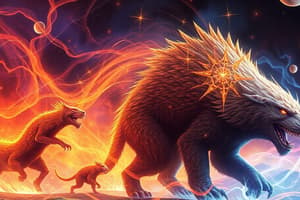Podcast
Questions and Answers
What defines subspecies in population classifications?
What defines subspecies in population classifications?
- Populations that exist in the same geographic region
- Populations that are geographically isolated
- Populations that differ in characteristics but interbreed (correct)
- Populations that cannot produce fertile offspring
Which of the following describes allopatric speciation?
Which of the following describes allopatric speciation?
- Species that occur in overlapping geographical areas
- Species evolving in the same habitat
- Species arising when isolated from one another (correct)
- Species that never interbreed even when in contact
What role do environmental factors play in species distribution?
What role do environmental factors play in species distribution?
- They are irrelevant to plant species composition
- They only influence animal species, not plants
- They are critical in determining which species live where (correct)
- They determine genetic diversity within a species
Which statement is true regarding endemic species?
Which statement is true regarding endemic species?
Which of the following best defines a biome?
Which of the following best defines a biome?
What is the difference between potential vegetation and current vegetation?
What is the difference between potential vegetation and current vegetation?
In which biome might you expect the most variation in rainfall?
In which biome might you expect the most variation in rainfall?
Which of the following describes the concept of 'ring species'?
Which of the following describes the concept of 'ring species'?
Which of the following life forms is classified as an annual?
Which of the following life forms is classified as an annual?
What primarily influences the metabolic rate of exothermic organisms?
What primarily influences the metabolic rate of exothermic organisms?
Which of the following factors is most crucial in the distinction between biomes?
Which of the following factors is most crucial in the distinction between biomes?
How do abiotic environmental conditions differ from biotic resources?
How do abiotic environmental conditions differ from biotic resources?
The term 'climate envelope' refers to which of the following?
The term 'climate envelope' refers to which of the following?
What type of environmental conditions are not directly consumable by organisms?
What type of environmental conditions are not directly consumable by organisms?
Which life form is not primarily defined by its growth type below ground level?
Which life form is not primarily defined by its growth type below ground level?
In terms of lifecycle influence, how do endothermic organisms differ from exothermic organisms?
In terms of lifecycle influence, how do endothermic organisms differ from exothermic organisms?
What is the term used for populations of a species that have genetically determined phenotypes adapted to local conditions?
What is the term used for populations of a species that have genetically determined phenotypes adapted to local conditions?
In terms of evolution, what does the term 'phenotypic plasticity' refer to?
In terms of evolution, what does the term 'phenotypic plasticity' refer to?
Which of the following processes adds alleles to a population, contributing to genetic variation?
Which of the following processes adds alleles to a population, contributing to genetic variation?
What characterizes divergent evolution?
What characterizes divergent evolution?
In evolutionary terms, what is the role of 'selection'?
In evolutionary terms, what is the role of 'selection'?
What is the significance of genetic drift in a population?
What is the significance of genetic drift in a population?
What is meant by the term 'speciation'?
What is meant by the term 'speciation'?
What describes the concept of co-evolution?
What describes the concept of co-evolution?
Study Notes
Subspecies
- Subspecies are different populations of the same species that have some distinct characteristics but can still interbreed and produce fertile offspring.
- Ring species are a complex group of interconnected subspecies that can interbreed with neighboring populations, but the "end" populations are too different to reproduce.
Speciation
- Allopatric speciation occurs when species evolve in isolation.
- Sympatric speciation takes place when species evolve while living in close proximity.
- The process of speciation can be visualized as a transition from an allopatric phase to a sympatric phase through a stage of secondary contact.
Biomes
- Biomes are groups of ecological communities characterized by their distinctive vegetation structure.
- The key factors determining biome distribution are temperature and precipitation.
- There are 8 main terrestrial biomes: deserts, grasslands, tropical forests, taiga, and tundra.
- The term "potential vegetation" refers to the vegetation types that should be present in a biome, while "current vegetation" describes the actual vegetation present.
- Human influence can lead to replacement communities, which differ from the potential vegetation.
Plant Functional Types
- Raunkiaer's life forms classify plants based on where they store their growing points (buds), such as in trees, shrubs, herbs, bulbs/rootstock plants, or seeds (annuals).
- These life forms are closely related to biome structure, reflecting the impact of climate.
- Plant functional types are often used in ecological models instead of specific species, as they provide sufficient yet manageable information.
Evolution
- Divergent evolution occurs when species originating from a common ancestor develop distinct traits.
- Convergent evolution happens when unrelated species develop similar traits in response to the environment.
- Mutations are the ultimate source of genetic variation, adding new alleles to a population.
- Selection removes alleles from a population, driven by environmental pressures.
- Genetic drift removes genetic variation from a population randomly and quickly.
- Natural selection acts on individuals within a population, favoring individuals with traits increasing their chances of survival and reproduction.
- Fitness refers to the relative contribution of an individual to the next generation.
- Genotype encompasses all genetic characteristics of an individual, while phenotype refers to the expressed characteristics.
- Phenotypic plasticity describes the ability of an individual to express different phenotypes based on environmental conditions.
- Co-evolution is the mutual selection process between interacting organisms.
Ecotypes and Species
- Ecotypes are populations of a species with distinct adaptations to local conditions, driven by long-term isolation and strong selection pressures.
- Speciation occurs when two species can no longer interbreed and produce fertile offspring.
Resources and Conditions
- Environmental conditions are abiotic factors influencing an organism's survival and reproduction.
- Resources are abiotic or biotic factors that are consumed.
- Environmental conditions are not consumable and vary in space and time.
- Climate envelope refers to the range of climactic conditions under which a species survives.
- Temperature influences species in various ways:
- Signaling: triggers processes like vernalization (germination after a cold period).
- Metabolic rate: impacts exothermic (cold-blooded) organisms, influencing their lifecycle and activity.
- Lifecycle: plays a smaller role in endothermic (warm-blooded) animals, as their metabolic rate is less temperature-dependent.
Studying That Suits You
Use AI to generate personalized quizzes and flashcards to suit your learning preferences.
Description
Explore the concepts of subspecies, speciation, and biomes in biology. This quiz covers allopatric and sympatric speciation, ring species, and the characteristics of various biomes. Test your understanding of how species evolve and adapt in different environments.




